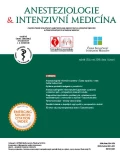Pre-hospital diagnosis of interstitial lung disease in patients presenting with shortness of breath – case series
Authors:
R. Škulec 1–3
Authors‘ workplace:
Klinika anesteziologie, perioperační a intenzivní medicíny, Univerzita J. E. Purkyně a Masarykova nemocnice v Ústí nad Labem
1; Zdravotnická záchranná služba Středočeského kraje, Kladno
2; Klinika anesteziologie, resuscitace a intenzivní medicíny, Fakultní nemocnice Hradec Králové, Lékařská fakulta v Hradci Králové, Univerzita Karlova
3
Published in:
Anest. intenziv. Med., 30, 2019, č. 1, s. 22-26
Category:
Overview
The author presents a case series of four patients presenting with shortness of breath who have been diagnosed with interstitial lung disease in the pre-hospital setting based on a combination of clinical examination and Point-of-Care chest ultrasound. Further specialized examinations in the hospital confirmed the diagnosis in all of them. The common primary diagnostic finding was a combination of severe shortness of breath, ultrasound finding of bilateral alveolo-interstitial syndrome with irregular distribution, bilateral weakening of pleural sliding and absence of echocardiographic signs of heart failure. The author discusses the potential contribution of Point-of-Care ultrasonography to making the diagnosis of interstitial lung disease during primary emergency examination of patients with shortness of breath.
Keywords:
shortness of breath – interstitial lung disease – Point-of-Care ultrasound
Sources
1. Šeblová J, Knor J. Urgentní medicína v klinické praxi lékaře. Praha: Grada, 2013.
2. Jesenak M, Banovcin P, Jesenakova B, Babusikova E. Pulmonary Manifestations of Primary Immunodeficiency Disorders in Children. Front Pediatr. 2014;2:1–13.
3. Wells AU, Hirani N. Interstitial lung disease guideline: The British Thoracic Society in collaboration with the Thoracic Society of Australia and New Zealand and the Irish Thoracic Society. Thorax. 2008;63(Suppl 5):1–58.
4. Šterclová MM, Vašáková M. Intersticiální plicní procesy – proč je potřeba správně stanovit diagnózu? Interní Med. 2013;15:261–262.
5. Vašáková M, Šterclová M, Anton J. Intersticiální plicní procesy – přehled, diferenciální diagnostika, vyšetřovací metody. Prakt Lek. 2007;87:461–468.
6. Lichtenstein DA. Lung ultrasound in the critically ill. Ann Intensive Care. 2014;4:1–12.
7. Murphy M, Nagdev A, Sisson C. Lack of lung sliding on ultrasound does not always indicate a pneumothorax. Resuscitation. 2008;77:270.
8. Avila JO, Noble VE. The Irregular Diaphragmatic Pleural Interface. J Ultrasound Med. 2015;34:1147–1157.
9. Pinal-Fernandez I, Pallisa-Nuñez E, Selva-O'Callaghan A. Pleural irregularity, a new ultrasound sign for the study of interstitial lung disease in systemic sclerosis and antisynthetase syndrome. Clin Exp Rheumatol. 2015;33(4 Suppl 91):S136–141.
10. Wang Y, Gargani L, Barskova T, et al. Usefulness of lung ultrasound B-lines in connective tissue disease-associated interstitial lung disease: a literature review. Arthritis Res Ther. 2017;19:206–215
Labels
Anaesthesiology, Resuscitation and Inten Intensive Care MedicineArticle was published in
Anaesthesiology and Intensive Care Medicine

2019 Issue 1
Most read in this issue
- Clinical presentation and management of phantom pain
- Caudal block in adult patients and its use in the perioperative period
- Epidural analgesia in obstetrics
- Anaesthesia information management systems in the Czech Republic – Are they still just a calling of the future?
